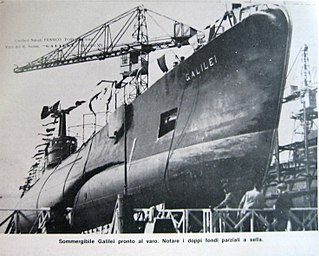Construction and career
Primo Longobardo was laid down at Fincantieri Monfalcone Shipyard on 19 December 1991 and launched on 20 June 1992. She was commissioned on 14 December 1993.
The boat, during its operational life, has carried out various activities at national and international level. Among the former there are both the classic institutional activities of the armed force such as surveillance in the enlarged Mediterranean in the context of the fight against maritime terrorism, and activities related to police tasks such as the repression of drug trafficking and the control of illegal immigration, and of protection environmental such as hydrocarbon pollution monitoring. Staff training is also carried out with participation in national exercises; with the naval air forces of the Naval Squad in the Open Sea, Amphex, Tirnav and Tiraer-Tireli cycles; in collaboration with the Underwater Operating Group in rescue training for submarines damaged in the Smerex cycles; with the Incursori Operational Group and the San Marco Regiment, now brigade, in training for Special Operations. International activities include NATO campaigns in the Mediterranean, Atlantic, Red Sea and Indian Ocean; in detail he participated in the operational cycles Dog Fish, Destined Glory, Loyal Midas, Noble Manta, Noble Mariner, Proud Manta, Dynamic Guard
Although initially equipped with 6 torpedo launchers for A-184 Mod.3 wire-guided torpedoes and capable of launching mines, during an update it was prepared for the use of anti-ship missiles. During 2011, in collaboration with the NATO Underwater Research Center (NURC), the boat experimented with the latest generation of acoustic and magnetic sensors and carried out numerous tests with AUVs equipped with bistatic sona

USS Pickerel (SS-524), a Tench-class submarine, was the second ship of the United States Navy to be named for a young or small pike.

The SEAL Delivery Vehicle (SDV) is a manned submersible and a type of swimmer delivery vehicle used to deliver United States Navy SEALs and their equipment for special operations missions. It is also operated by the Royal Navy's Special Boat Service, which operates three SDVs.

The Regia Marina was the navy of the Kingdom of Italy from 1861 to 1946. In 1946, with the birth of the Italian Republic, the Regia Marina changed its name to Marina Militare.

Libyan Navy is the branch of the Libyan military responsible for naval warfare. Established in November 1962, Libyan Navy has been headed by Admiral Mansour Bader, Chief of Staff of the Libyan Naval Force. Before the Libyan Civil War it was a fairly typical small navy with a few missile frigates, corvettes and patrol boats to defend the coastline, but with a very limited self-defence capability. The Navy has always been the smallest of Libya's services and has always been dependent on foreign sources for equipment, spare parts, and training. Most of the Gaddafi era fleet was destroyed in 2011. Since the start of the ongoing internal conflict, the Libyan Navy is aligned with the Government of National Accord (GNA), led by the Presidential Council in Tripoli, apart from coastal patrol vessels under the control of the Libyan National Army.

The Battle of the Mediterranean was the name given to the naval campaign fought in the Mediterranean Sea during World War II, from 10 June 1940 to 2 May 1945.

Italian submarine Iride was a Perla-class submarine built for the Royal Italian Navy during the 1930s. Originally, she was named Iris until July 1936, but was renamed shortly before her launch.

The Nazario Sauro class are diesel-electric submarines operated by the Italian Navy. All boats were built by Fincantieri in Monfalcone.

Galileo Galilei was one of four Archimede-class submarines built for the Regia Marina during the early 1930s. She was named after Galileo Galilei, an Italian astronomer and engineer.

HMS Unrivalled (P45) was a U-class submarine built for the Royal Navy during World War II. The boat has been the only ship of the Royal Navy to ever bear the name Unrivalled. Completed in 1942, the boat spent most of the war in the Mediterranean. She sank a number of small merchant ships and naval auxiliaries, but major success eluded her during the war. Too small and slow for the post-war environment, Unrivalled was scrapped in 1946.

The Adriatic campaign of World War II was a minor naval campaign fought during World War II between the Greek, Yugoslavian and Italian navies, the Kriegsmarine, and the Mediterranean squadrons of the United Kingdom, France, and the Yugoslav Partisan naval forces. Considered a somewhat insignificant part of the naval warfare in World War II, it nonetheless saw interesting developments, given the specificity of the Dalmatian coastline.

The SACLANT ASW Research Centre was the predecessor to the NATO Undersea Research Centre. It was known as The SACLANT ASW Research Centre from 1959 through 1986, and the SACLANT Undersea Research Centre from 1987 through 2003. The centre was commonly referred to as SACLANTCEN.

The Argo-class was a class of two coastal submarines built by Cantieri Riuniti dell'Adriatico in Monfalcone for Portugal but operated by the Royal Italian Navy after Portugal was unable to pay construction costs. The submarines were built in 1936, and both served in the Mediterranean Sea at the start of the Second World War. The boats were transferred to the BETASOM Atlantic submarine base at Bordeaux in 1940, but returned to the Mediterranean in 1941, where both were sunk within a few days of the September 1943 Italian armistice.

Delfino was one of four Squalo-class submarines built for the Regia Marina during the late 1920s. The boat served in World War II and was sunk in 1943 after a collision with another Italian ship.
Pietro Calvi was the lead ship of her class of two submarines built for the Regia Marina during the 1930s. Completed in 1936, she played a minor role in the Spanish Civil War of 1936–1939 supporting the Spanish Nationalists. The submarine made multiple patrols in the Atlantic Ocean during the Second World War, sinking seven Allied ships. Pietro Calvi was rammed and sunk by a British convoy escort in July 1942.

Italian submarine Tembien was an Adua-class submarine built for the Royal Italian Navy during the 1930s. It was named after a Tembien region of Ethiopia, where Italian troops fought two battles against more numerous Ethiopian troops during the Second Italo-Ethiopian War.

Zeffiro was one of eight Turbine-class destroyer built for the Regia Marina during the 1920s. She was named after a westerly wind, Zeffiro, common in summer in the Mediterranean. The ship played a minor role in the Spanish Civil War of 1936–1937, supporting the Nationalists.

Turbine was the lead ship of her class of eight destroyers built for the Regia Marina during the 1920s. Her name means whirlwind.
Argo was the lead ship of her class of two submarines ordered by the Portuguese government, but taken over and completed for the Regia Marina during the 1930s.
Luigi Settembrini was the lead ship of her class of two submarines built for the Regia Marina during the early 1930s. She played a minor role in the Spanish Civil War of 1936–1939 supporting the Spanish Nationalists.
Primo Longobardo was an Italian naval officer and submariner during World War II.
This page is based on this
Wikipedia article Text is available under the
CC BY-SA 4.0 license; additional terms may apply.
Images, videos and audio are available under their respective licenses.

















